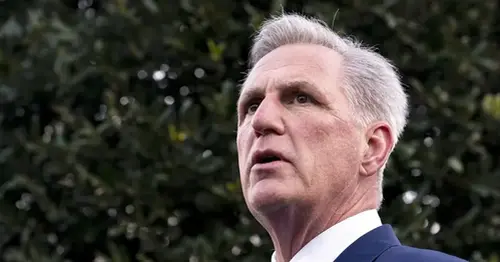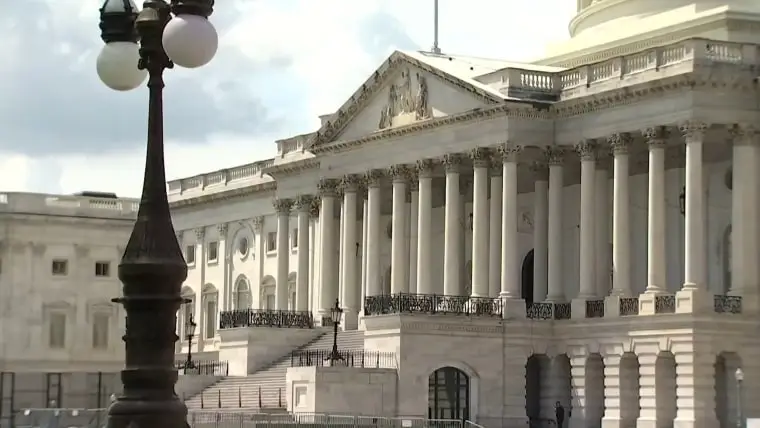
Can Democrats force a debt ceiling vote? It’s possible
WASHINGTON — Soon after they relinquished control of the House, Democrats quietly planted a Trojan horse-style bill that could be used to try to force the GOP majority into a debt ceiling vote that most Republicans wanted to avoid.
Their plan, which involves the use of a little-known tool called a “discharge petition,” was revealed Tuesday as the clock ticks to June 1, when the Treasury Department says the U.S. could run out of cash and be forced into an unprecedented default.
Speaker Kevin McCarthy, R-Calif., and Republicans are seeking to attach a series of unspecified spending cuts and a rollback of parts of President Joe Biden's agenda to a debt limit bill, which Democrats say is a nonstarter.
Congress deadlocked on debt ceiling increase ahead of June deadline
May 2, 202301:58But can Democrats force a vote? It would require them to overrun GOP leaders in a chamber where the minority party typically has little power and no control over the floor.
Here’s what Democrats are trying to do — and what happens next.
What is a discharge petition?
It’s a rare tool the House’s minority party has to bring up votes on bills. It requires signatures from 218 members — a majority of the chamber — to force a vote on the floor, regardless of whether the speaker or majority leader wants that to happen.The first step in the process is having a bill sit in committee for at least 30 legislative days, meaning days that the House is in session. Weekends and district work periods, when members go home, do not count, so this can take some time.
House Minority Leader Hakeem Jeffries, D-N.Y., wrote to Democrats on Tuesday to say that such a bill existed and has passed the 30-day waiting period: the Breaking the Gridlock Act quietly introduced by Rep. Mark DeSaulnier, D-Calif., in late January.
How did we get here?
It began under the radar. DeSaulnier said he started having informal conversations when the 118th Congress convened with Rules Committee Ranking Member Jim McGovern, D-Mass., about crafting a plan that would allow Democrats to bring emergency measures to the floor.
“The overall goal was to have a vehicle that if we needed it, we could break the glass and save the country or save a policy that we really felt was urgent, given my perception of what was happening in the Republican caucus at that time,” DeSaulnier told NBC News on Tuesday. “Don’t forget, this was right after we had 15 votes to select the speaker.”
The Breaking the Gridlock Act, in its original form, has nothing to do with the debt limit; its actual text is about creating a task force to support grandparents. That’s because the text is designed to be replaced — DeSaulnier envisioned it being used not just for the debt limit but also for “an assault weapon ban, potentially something around abortion.”
Democrats wrote it to be so legislatively wide-ranging that it was referred to 20 committees in January, allowing it to reach the 30 legislative days requirement.
So how can a bill not explicitly written to raise the debt limit be used to do just that? Well, it will need to be amended, a process that started this week.
Will a discharge petition work?
Discharge petitions are designed to be difficult and they are rarely successful. Since 2000, there have only been two instances where a discharge petition received the necessary 218 signatures, according to a Congressional Research Service report. One was in 2015 on a special rule reauthorizing the Export-Import Bank, and the other was in 2002 on a rule related to a campaign finance measure.
Special rule introduced
Before the House votes on a bill, the body typically has to approve a rule, which establishes whether bills can be amended and how much debate time is permitted. On Tuesday, McGovern introduced a special rule laying the groundwork for a discharge petition.
McGovern’s rule would allow DeSaulnier’s bill to be amended, so Democrats could add language that would raise the debt ceiling. McGovern’s rule is not the discharge petition; it is simply the first step in the process.
What comes next for Congress?
Democrats only have a few weeks to act before Treasury's June 1 deadline, and the process is long.
Due to another required waiting period, the earliest the actual discharge petition could be filed is May 16. That would then begin the process of gathering signatures.
The petition needs 218 signatures, a majority of members of the House. So all 213 Democrats would need at least five Republicans to join the effort. That will be very difficult for Democrats to achieve. Even if some in the GOP are sympathetic, signing on to a discharge petition would be a major snub to McCarthy.
If they do get the signatures, the bill waits another seven legislative days on the floor, and McCarthy must schedule it for a vote within two days.
Even if everything went to plan and this bill was to get through the House, it would have to pass the Senate unchanged (which requires 60 votes) in order to proceed to Biden’s desk.
Rep. Kelly Armstrong, R-N.D., gave a direct answer when asked if he thinks Democrats will succeed at getting the 218 votes: “No, I don’t.”
“My understanding is they are two weeks away from even being able to get signatures. If they think they can do nothing in that time except give inflammatory speeches and demonize our attempt to try and bring some fiscal sanity to D.C., they are moving us dangerously close to default,” Armstrong said. “Not if their posture is 'we won’t negotiate anything.' We passed a bill. The Senate should pass a bill.”
House Democrats' goal is to put pressure on politically vulnerable Republicans in competitive or Biden-won districts to sign on to the discharge petition. If they have a path to five, that's where it'll be.
Debt ceiling talks continue
Of course, this could all change if McCarthy and Biden reach a deal.
“This is a rapidly evolving situation, and maybe the legislative dynamics would be different in two weeks,” a senior House Democratic aide said. “But we wanted to do the responsible thing, introduced this bill … so that our options remain as open as possible.”







